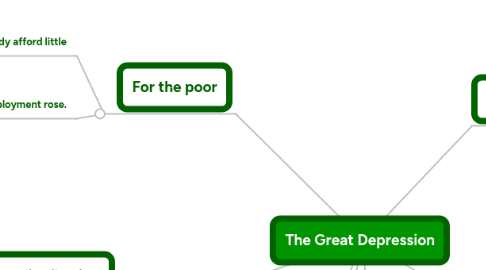
1. For the poor
1.1. the poor could already afford little
1.2. unemployment rose.
1.2.1. government didn't help at first
1.2.2. people couldnt buy anything so prodctivity decreased along with employment
2. uneven distribution of wealth
2.1. .1% people are very wealthy. 42% people are very poor. 58% are "middle class" people. they have jobs, but depend on their paychecks to get them through.
2.1.1. if these people dont have jobs then they dont have money to buy products then factories have to decrese their product amount and sell less, and then loose money then they have to lay people then there are less people with jobs to buy the product
3. President Hoovers Reponse
3.1. didnt believe that the government should play an active role in the economy
3.2. he persuaded bankers and business to follow Voluntary Non- Coercive Cooperation
3.2.1. He gave tax breaks in return for private sector economic investment
3.3. He organized some private relief agencies for the unemployment
3.4. he had European countries purchase american goods instead of paying war debt and reparations payments
4. Tariff wars
4.1. democrats in congress passed a high tariff to protect U.S industry
4.1.1. hoped to stimulate purchasing of U.S goods
4.1.2. Failed
4.1.2.1. congress didnt understand that the world had become a Global Economy
4.2. in retaliation other countries passed high tariffs and no foreign markets purchased American goods.
4.2.1. U.S productivity decresed again
5. The New Deal
5.1. FDR Created "the New Deal"
5.2. it was a revolution in American Society
5.2.1. Completely changed the way government functioned
5.3. Phase 1
5.3.1. Deals exculisvely with economic reform. FDR believed legislation involvement was crucial to help economy
5.3.2. Step 1-The banking crisis aka "Banking Holiday"- banks shut down and subject to government inspection. Banks were allowed to open again when they were "healthy" or the peoples confidence returned
5.3.3. Step 2- Stock market reform aka "security Exchange Commission" Practice of buying on margin was regulated
5.3.4. Step 3- Put more money in circulation. FDR went off the " Gold Standard" (government could print off more money than Fort Knox gold reserves would allow) But with more money wages and prices increased (aka inflamation) dollar value to lower- that gave government spending power
6. crash
6.1. banks were quick to make loans
6.2. people were buying stocks then flipping them quickly to make a quick buck
6.2.1. the companies needed long term investments so they could pay bills
6.3. people started selling all at once making the market bottom out
6.3.1. "panic selling" supply and demand, unequal. everyone is selling stocks nobody buys
6.4. the crash had a ripple effect on the economy
7. productivity and unemployment
7.1. 1924-1927 productivity capacity doubled because of technological innovation.
7.2. people were not being hired because machines were making the products.
7.2.1. because machines were doing the peoples job, people were more and more unemployed and not making mopney to buy the products being made.
